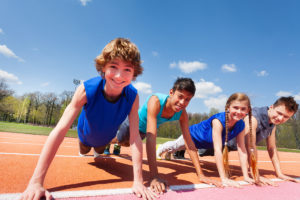Anatomy/Kinesiology
Childhood Activity and Midlife Brain Fitness
Here’s one more solid reason to inspire kids to exercise. The secret to maintaining cognitive fitness later in life may lie in getting active while young and staying active throughout teen, young-adult and middle-aged years.
First-Time Marathon Training Has Anti-Aging Effect
Here’s a good reason to encourage your midlife clients to try an inaugural running event. First-time marathon runners who trained for 6 months saw a 4-year reduction in arterial age, according to study findings presented at EuroCMR 2019, a scientific congress of the European Society of Cardiology.
Minimalist Shoes and Stronger Foot Muscles
Minimalism is trending in many areas of life, including athletic shoes, with many fans touting numerous benefits. But does the evidence support the hype? Yes, according to research findings published in Medicine & Science in Sports & Exercise (2018; doi:10.1249/MSS.0000000000001751). Walking in minimalist shoes is as effective as foot-strengthening exercises and may result in better compliance than doing specific exercises.
Having the Bone Health Talk With Clients
Clients may ask you about calories or how to “tone,” but how often do they ask questions about bone health and osteoporosis? If clients aren’t asking these questions, they should: 54 million adult Americans are at risk of breaking a bone (NOF 2019a). You probably already know that people who have osteoporosis should do weight-bearing exercises to slow the degradation and ease the effects. However, most people are given no more explanation than that. You may be in a position to offer answers to some of your clients’ questions.
Muscle Cramps? Find Out Why
Muscle cramps can stop athletes in their tracks. Although they usually self-extinguish within seconds or minutes, the abrupt, harsh, involuntary muscle contractions can cause mild-to-severe agony and immobility, often accompanied by knotting of the affected muscle (Minetto et al. 2013). And cramps are common; 50%–60% of healthy people suffer muscle cramps during exercise, sleep or pregnancy or after vigorous physical exertion (Giuriato et al. 2018).
Alternative Pain Relief by Incrediwear
How much do you think your clients spend on pain relief? It’s a rhetorical question, but statistics show that the annual cost of healthcare due to pain ranges from $560 billion to $635 billion in 2010. This is in the United States alone, which combines the economic and medical costs to disability days, lost wages, and productivity.
Increase Neuromuscular Power for Your Athlete Clients
Competitive athletes often train for peak neuromuscular power to excel at the complex movements their sports require. Many personal training clients want to apply the same principle to their favorite sports.
With the right power training, fitness competitors can improve their tennis serve, golf swing, running speed, volleyball spike, soccer performance, basketball vertical jump and so on.
Aching for the Quadratus Lumborum
Many of your clients likely work desk jobs and sit most of the day. This is not an ideal situation for many reasons, one being the risk of developing chronic lower-back pain. If you or a client is experiencing aches or sharp pains in the lower back, the issue may stem from problems with the quadratus lumborum.
2019 IDEA® World Convention: Igniting Passion With Purpose!
Purpose, passion and people! The fitness industry is all about forging relationships that lift others up. Fitness professionals have energy to spare, and they are dedicated to mentoring new generations of pros, networking with peers, and motivating clients and participants every day.
Power Training vs. Strength Training for Older Adults
For maintaining functional ability—and potentially even for living longer—growing research
supports the benefits of power training, particularly as we age. Power is the ability to move weight with speed and to generate force and velocity with coordinated movement.
Using Anti-Rotation to Coach Rotation
When you watch someone hit a golf ball, throw a punch or simply retrieve groceries from the car, it’s evident that human movement occurs in all three planes of motion. A review of basic core anatomy—major muscles attached to the trunk, above the ischial tuberosity and below the superior aspect of the sternum—reveals that 87.5% of the core muscles are oriented either diagonally or horizontally, and one action that these muscles perform is rotation (Santana 2000).
The Science of Pilates Research
When Victor Sanakai was playing tennis for the Auburn University Montgomery National Championship team, he thought he was going to need rotator cuff surgery. But first he sought the advice of Michele Olson, PhD, a Pilates researcher who works with student athletes.
Olson, a senior clinical professor of sport science at Huntingdon College in Montgomery, Alabama, suggested Sanakai try Pilates exercises for the shoulders, upper back and abdominals.
Exercise and Pain: Teaching Clients to Follow the Signs
Until recently pain has been thought to be an indicator of the amount of tissue injury present in the body. The belief is that a high amount of pain equates to a serious injury, and a small amount of pain equates to a minor injury. However, through extensive research, we now know that pain has surprisingly little correlation to the amount of tissue damage present. For example, it’s estimated that 40% of people without any low back pain have at least one “bulging” disc on a lumbar spine MRI.
Getting to the Bottom of the Piriformis
Every time you take a step, your piriformis muscles help to keep your stride in good form.
The piriformis is a flat, pyramid-shaped muscle in the gluteal region (you have one on each side of the body). Located behind the gluteus maximus, the piriformis attaches to the base of the spine (the sacrum) on one end and to the top of the femur, the trochanter, on the other end (Kenhub 2019; Chang, Jeno & Varacallo 2019).
Variable Resistance Training With Deadshifts and Deadlifts
It’s 2 a.m. Your 3-month-old son is screaming at the top of his tiny lungs, waking up everyone in the household. Begrudgingly, you get out of bed and zombie-walk over to your son’s crib in the next room. Your body aches, you haven’t slept in days, and now you must bend over to pick up a squirming child in the dead of night. Unfortunately, your son’s not a great strength coach and doesn’t allot enough warmup time to prepare your body for a deadlift.
The Food-Inflammation Connection
Many of the foods we eat—especially vegetables—can help us deal with the double-edged sword of inflammation.
How Strength Training Impacts Metabolism
Strength training (or resistance training) does much more than build strong muscles and bones. Research in the past few years has confirmed that lifting weights changes human metabolism in ways that improve health and well-being. Resistance exercise improves resting metabolic rate and cardiorespiratory fitness. Indeed, some authors call strength training an exercise therapy program (Strasser & Schobersberger 2011).
A Nod to Scalenes
How much do you know about your scalene muscles? If you just tilted your head in confusion, you can attribute that simple movement, in part, to your scalenes, three pairs of muscular tissue that flank the sides of the neck.
Anterior scalenes, on the front side of the neck, connect the third through sixth cervical vertebrae to the first rib.
Breath and Movement for Core Stability
When your participants ask about their core muscles, they’re most likely referring to the lauded “six-pack.” As a fitness instructor, you may think about transversus abdominis, obliques and pelvic-floor muscles. But almost everyone tends to forget about the diaphragm.
Gender Differences in Fitness and Brain Function
Many studies show that cardiorespiratory fitness improvements boost brain fitness in later life. New research in the Journal of Applied Physiology (2019; doi:10.1152/japplphysiol.01046.2018) reveals that effects may differ between men and women.



















